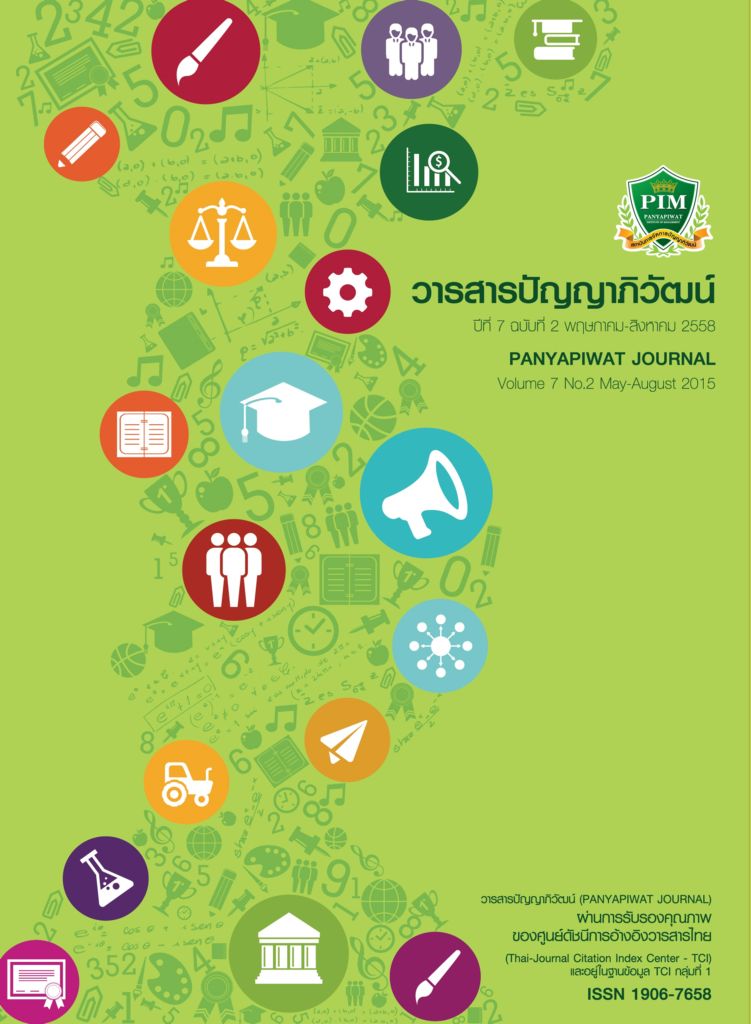A STUDY OF COLLOCATION USAGE IN FOOD AND BEVERAGE ADVERTISEMENTS
Main Article Content
Abstract
Abstract
As food and beverage business has been popular and increasingly evolved in education system. Educational programs in this area have been developed rapidly in Thailand, a parallel to the upgrade to become A World Kitchen. Therefore, it is essential for students to ably convey their knowledge and experience in English as a native-like. This study aimed to 1) investigate the use of collocations in food and beverage advertisements, 2) analyze types of lexical and grammatical collocations, and the frequently used ones, and 3) prove that lexical collocations and grammatical collocations in food and beverage advertisements are independent of each other. The purposing sampling was used to collect data. The sources of data in the study were the food and beverage advertisements taken from the Bangkok Post published in 2012, and the Internet advertisements from 2008 to 2012 to get 300 words as expected. The words were chosen by referring to Benson et al.’s theory. The data were analyzed by chi square. The research results were as follows: 1) there were 183 lexical collocations and 59 grammatical collocations, and lexical collocations were used more frequently than grammatical collocations, 2) more subcategories of standard patterns of both collocations, it was found that “adjective + noun” occurred most frequently, and 3) the numbers of lexical collocations and grammatical collocations were significantly different at 0.001 proving that they were independent of each other.
บทคัดย่อ
ธุรกิจเกี่ยวกับอาหารและเครื่องดื่มกำลังได้รับความนิยมและมีความเกี่ยวข้องในระบบการศึกษา การจัดการ
ศึกษาสาขาวิชานี้เติบโตอย่างรวดเร็วในประเทศไทย เพื่อให้สอดคล้องกับการก้าวสู่การเป็นห้องครัวโลก ด้วยเหตุนี้จึงจำเป็นสำหรับนักศึกษาที่จะต้องมีความสามารถในการใช้ความรู้และประสบการณ์เกี่ยวกับอาหารและเครื่องดื่มเป็นภาษาอังกฤษได้ถูกต้องเหมือนเจ้าของภาษา งานวิจัยนี้มีจุดประสงค์เพื่อ 1) สืบค้นรูปแบบการใช้คำปรากฏร่วมในโฆษณาอาหารและเครื่องดื่ม 2) วิเคราะห์ประเภท และความถี่ในการใช้คำปรากฏร่วมเชิงคำศัพท์และเชิงไวยากรณ์และ 3) ศึกษาความสัมพันธ์ระหว่างคำปรากฏร่วมเชิงคำศัพท์และเชิงไวยากรณ์ในโฆษณาอาหารและเครื่องดื่ม ข้อมูลในการวิจัยได้มาโดยการสุ่มตัวอย่างแบบเจาะจงจากโฆษณาอาหารและเครื่องดื่มในหนังสือพิมพ์ที่หาได้ง่าย เช่น บางกอกโพสต์ ปี พ.ศ. 2555 และโฆษณาในอินเทอร์เน็ตระหว่างปี พ.ศ. 2551-2555 เพื่อให้ได้จำนวนคำตามที่กำหนดประมาณ 300 คำ การเลือกคำปรากฏร่วมใช้อ้างทฤษฎีของเบ็นสันและคณะ การวิเคราะห์ข้อมูลใช้สถิติไคสแควร์ ผลการวิจัยพบว่า 1) คำปรากฏร่วมเชิงคำศัพท์ 183 คำ และคำปรากฏร่วมเชิงไวยากรณ์ 59 คำ คำปรากฏร่วมเชิงคำศัพท์มีความถี่ในการใช้มากกว่าคำปรากฏร่วมเชิงไวยากรณ์ 2) รูปแบบคำปรากฏร่วมเชิงคำศัพท์และเชิงไวยากรณ์ในโฆษณาอาหารและเครื่องดื่มมีมากกว่าทฤษฎีของเบ็นสัน คือ มีคำคุณศัพท์ขยายคำนามพบมากที่สุด และ 3) คำปรากฏร่วมเชิงคำศัพท์และเชิงไวยากรณ์มีความแตกต่างกันอย่างมีนัยสำคัญทางสถิติที่ 0.001
Article Details
I and co-author(s) certify that articles of this proposal had not yet been published and is not in the process of publication in journals or other published sources. I and co-author accept the rules of the manuscript consideration. Both agree that the editors have the right to consider and make recommendations to the appropriate source. With this rights offering articles that have been published to Panyapiwat Institute of Management. If there is a claim of copyright infringement on the part of the text or graphics that appear in the article. I and co-author(s) agree on sole responsibility.
References
Abadi, H. (1990). A study of the Learning of English Lexical and Grammatical Collocations by Iranian EFL Learners. Iran: The University of Science and Aeronautical Technology Tehran.
Bahns, J. (1993). Lexical collocations: A contrastive view. ELT Journal, 47(1), 57.
Benson, M., Benson, E. & Ilson, R. (1986). Lexicographic Description of English. Amesterdam and Philadeiphia: John Benjamins.
Claire, L. W. (2007). Chinese Collocation Extraction and its Application in Natural Language Processing.Doctor of Philosophy Thesis, The Hong Kong Polytechnic University.
Farrokh, P. & Alizadeh, M. (2013). English Grammatical Collocations in Azeri. AEL, 2(2), 123.
Firth, J. R. (1957). Modes of meaning. London: Oxford University Press.
Giang, H. T. H. (2010). A Study on the Pragmatic Features of Collocation Used in Advertising Hair Care Product in English and Vietnamese. Doctor of Philosophy Thesis in The English Language, University of Danag.
Hoey, M. (2005). Lexical priming: A new theory of words and language. London: Routledge.
Krenn, B. (2000). Collocation Mining: Exploiting Corpora for Collocation Identification and Representation. Journal of Monetary Economics, Proceedings of KONVENCS 2000, Ilmenau, Deutschland.
Kuo, C. L. (2009). An Analysis of The Use of Collocation by Intermediate EFL College Students in Taiwan. ARECLS. (6), 141-155.
McIntosh, C. (2009). Oxford Collocations Dictionary for students of English. (2nd ed.). London: Oxford University Press.
McKeown K. R. & Radev D. R. (2000). Collocations. Department of Computer Science. New York: Columbia University. Oxford English Dictionary of Collocations (2002), London: Oxford University Press.
Prosad, L. (2009). Seven Types of meaning in Semantics. AM.A Project. Retrieved May 30, 2013, from http://universeofenglish.blogspot.com/2009/02/seven-types-of-meaning-in-semantics.html
Prowriting.aids. (2012). Collocations Dictionary. Retrieved October 1-31, 2012, from http:.//prowritingaids.com/Collocations.aspx
Rundell, M. (2010). Macmillan Collocations Dictionary. Oxford: Macmillan Publishers Limited.
Woolard, G. (2000). Collocation-encouraging learner independence. Teaching collocation: further developments in the lexical approach. London: Language Teaching publications.


